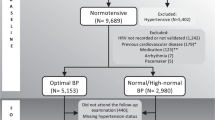Abstract
Purpose
Resting heart rate variability (HRV) is an important biomarker linking mental health to cardiovascular outcomes. However, resting HRV is also impaired in autonomic neuropathy, a common and underdiagnosed complication of common medical conditions which is detected by testing autonomic reflexes. We sought to describe the relationship between autonomic reflex abnormalities and resting HRV, taking into consideration medical comorbidities and demographic variables.
Methods
Participants (n = 209) underwent a standardized autonomic reflex screen which was summarized as the Composite Autonomic Severity Score (CASS) and included measures of reflexive HRV, e.g., heart rate with deep breathing (HRDB). Resting HRV measures were: pNN50 (percentage of NN intervals that differ by > 50 ms) and cvRMSSD (adjusted root mean square of successive differences).
Results
In univariate analyses, lower resting HRV was associated with: older age, higher CASS, neuropathy on examination, hypertension, diabetes, chronic obstructive pulmonary disease, chronic kidney disease, and psychiatric disease. Adaptive regression spline analysis revealed that HRDB explained 27% of the variability in resting HRV for participants with values of HRDB in the normal range. Outside this range, there was no linear relationship because: (1) when HRDB was low (indicating autonomic neuropathy), resting HRV was also low with low variance; and (2) when HRDB was high, the variance in resting HRV was high. In multivariate models, only HRDB was significantly independently associated with cvRMSSD and pNN50.
Conclusion
Subclinical autonomic neuropathy, as evidenced by low HRDB and other autonomic reflexes, should be considered as a potential confounder of resting HRV in research involving medically and demographically diverse populations.

Similar content being viewed by others
References
McCraty R, Shaffer F (2015) Heart rate variability: new perspectives on physiological mechanisms, assessment of self-regulatory capacity, and health risk. Glob Adv Health Med 4(1):46–61
Kleiger RE et al (1987) Decreased heart rate variability and its association with increased mortality after acute myocardial infarction. Am J Cardiol 59(4):256–262
Fang SC, Wu YL, Tsai PS (2020) Heart rate variability and risk of all-cause death and cardiovascular events in patients with cardiovascular disease: a meta-analysis of cohort studies. Biol Res Nurs 22(1):45–56
Heart rate variability: standards of measurement, physiological interpretation and clinical use. Task force of the European society of cardiology and the North American society of pacing and electrophysiology. Circulation (1996) 93(5): 1043–65
Steger A et al (2019) Polyscore of Non-invasive Cardiac Risk Factors. Front Physiol 10:49
Sassi R et al (2015) Advances in heart rate variability signal analysis: joint position statement by the e-cardiology ESC working group and the european heart rhythm association co-endorsed by the Asia Pacific heart rhythm society. Europace 17(9):1341–1353
Carthy ER (2014) Autonomic dysfunction in essential hypertension: a systematic review. Ann Med Surg (Lond) 3(1):2–7
Palatini P, Julius S (2009) The role of cardiac autonomic function in hypertension and cardiovascular disease. Curr Hypertens Rep 11(3):199–205
Chalmers JA et al (2014) Anxiety disorders are associated with reduced heart rate variability: a meta-analysis. Front Psychiatry 5:80
Shaffer F, Ginsberg JP (2017) An overview of heart rate variability metrics and norms. Front Public Health 5:258
Thayer JF, Yamamoto SS, Brosschot JF (2010) The relationship of autonomic imbalance, heart rate variability and cardiovascular disease risk factors. Int J Cardiol 141(2):122–131
Lampert R et al (2008) Decreased heart rate variability is associated with higher levels of inflammation in middle-aged men. Am Heart J 156(4):759.e1–7
Clamor A et al (2016) Resting vagal activity in schizophrenia: meta-analysis of heart rate variability as a potential endophenotype. Br J Psychiatry 208(1):9–16
Liu Y et al (2021) Altered heart rate variability in patients with schizophrenia during an autonomic nervous test. Front Psychiatry 12:626991
Benjamin BR et al (2021) Heart rate variability is associated with disease severity in psychosis spectrum disorders. Prog Neuropsychopharmacol Biol Psychiatry 111:110108
Agelink MW et al (2002) Relationship between major depression and heart rate variability clinical consequences and implications for antidepressive treatment. Psychiatry Res 113(1–2):139–49
Thayer JF, Lane RD (2000) A model of neurovisceral integration in emotion regulation and dysregulation. J Affect Disord 61(3):201–216
Smith R et al (2017) The hierarchical basis of neurovisceral integration. Neurosci Biobehav Rev 75:274–296
Askgaard G et al (2011) Decreased heart rate variability in HIV positive patients receiving antiretroviral therapy: importance of blood glucose and cholesterol. PLoS ONE 6(5):e20196
Benseñor IM et al (2011) Heart rate variability in HIV patients, diabetics, and controls: the AGATAA study. ISRN Vasc Med 2011:876864
Lebech AM et al (2007) Autonomic dysfunction in HIV patients on antiretroviral therapy: studies of heart rate variability. Clin Physiol Funct Imaging 27(6):363–367
Pagani M et al (1988) Spectral analysis of heart rate variability in the assessment of autonomic diabetic neuropathy. J Auton Nerv Syst 23(2):143–153
Stogios N et al (2021) Autonomic nervous system dysfunction in schizophrenia: impact on cognitive and metabolic health. npj Schizophrenia 7(1):22
Joe PCJ, Piras E, Wallach DS, Robinson-Papp J, Boka E, Brooke Remsen B, Bonner M, Goetz D, Hoffman K, Lee J, Fendrich S, Gonen O, Malaspina D (2021) An integrative study of the microbiome gut-brain-axis and hippocampal inflammation in psychosis: persistent effects from mode of birth. Schizophrenia Res. https://doi.org/10.1016/j.schres.2021.09.019
Liu YW et al (2016) Reduced cardiac autonomic response to deep breathing: a heritable vulnerability trait in patients with schizophrenia and their healthy first-degree relatives. Psychiatry Res 243:335–341
Agelink MW et al (2001) Standardized tests of heart rate variability: normal ranges obtained from 309 healthy humans, and effects of age, gender, and heart rate. Clin Auton Res 11(2):99–108
Freeman R et al (1991) Spectral analysis of heart rate in diabetic autonomic neuropathy a comparison with standard tests of autonomic function. Arch Neurol 48(2):185–90
Sega S, Jager F, Kiauta T (1993) A comparison of cardiovascular reflex tests and spectral analysis of heart rate variability in healthy subjects. Clin Auton Res 3(3):175–182
Gerritsen J et al (2003) Measures of cardiovascular autonomic nervous function: agreement, reproducibility, and reference values in middle age and elderly subjects. Diabetologia 46(3):330–338
Ewing DJ et al (1991) Twenty four hour heart rate variability: effects of posture, sleep, and time of day in healthy controls and comparison with bedside tests of autonomic function in diabetic patients. Br Heart J 65(5):239–244
Sharpee TO et al (2016) 25th Annual Computational Neuroscience Meeting: CNS-2016. BMC Neurosci 17(Suppl 1):54
Neblett EW Jr, Roberts SO (2013) Racial identity and autonomic responses to racial discrimination. Psychophysiology 50(10):943–53
Robinson-Papp J et al (2013) Autonomic dysfunction is common in HIV and associated with distal symmetric polyneuropathy. J Neurovirol 19(2):172–180
Robinson-Papp J, Sharma SK (2013) Autonomic neuropathy in HIV is unrecognized and associated with medical morbidity. AIDS Patient Care STDS 27(10):539–543
Robinson-Papp J et al (2017) Assessment of autonomic symptoms in a medically complex, urban patient population. Clin Auton Res 27(1):25–29
Low PA (1993) Composite autonomic scoring scale for laboratory quantification of generalized autonomic failure. Mayo Clin Proc 68(8):748–752
Spiers JP et al (1993) Time and frequency domain assessment of heart rate variability: a theoretical and clinical appreciation. Clin Auton Res 3(2):145–158
Niskanen J-P et al (2004) Software for advanced HRV analysis. Comput Methods Programs Biomed 76(1):73–81
Rodríguez-Liñares L, Vila XA, Méndez AJ, Lado MJ, Olivieri D (2008) R-HRV: An R-based software package for heart rate variability analysis of ECG recordings. In 3rd iberian conference in systems and information technologies (CISTI 2008). Ourense, Spain, p 565–574
Tarvainen MP, Ranta-aho PO, Karjalainen PA (2002) An advanced detrending method with application to HRV analysis. IEEE Trans Biomed Eng 49(2):172–175
Mateo J, Laguna P (2003) Analysis of heart rate variability in the presence of ectopic beats using the heart timing signal. IEEE Trans Biomed Eng 50(3):334–343
Osman HA, Eid M, Saddik AE (2015) A pattern-based windowed impulse rejection filter for nonpathological HRV artifacts correction. IEEE Trans Instrum Meas 64(7):1944–1957
Pearson RK et al (2016) Generalized hampel filters. EURASIP J Adv Signal Process 2016(1):87
Ghaleb FA et al (2018) Two-stage motion artefact reduction algorithm for electrocardiogram using weighted adaptive noise cancelling and recursive hampel filter. PLoS ONE 13(11):e0207176
de Geus EJC et al (2019) Should heart rate variability be “corrected” for heart rate? biological, quantitative, and interpretive considerations. Psychophysiology 56(2):e13287
Fahn S, Elton RL (1987) UPDRS program members. Unified Parkinsons Disease Rating Scale. In: Fahn S, Marsden CD, Goldstein M, Caine DB (eds) Recent developments in Parkinson’s disease, vol 2. Macmillan Healthcare Information, Florham Park, pp 153–163
Cornblath DR et al (1999) Total neuropathy score: validation and reliability study. Neurology 53(8):1660–1664
Rajendra Acharya U et al (2006) Heart rate variability: a review. Med Biol Eng Comput 44(12):1031–1051
Sinnreich R et al (1998) Five minute recordings of heart rate variability for population studies: repeatability and age-sex characteristics. Heart 80(2):156–162
Umetani K et al (1998) Twenty-four hour time domain heart rate variability and heart rate: relations to age and gender over nine decades. J Am Coll Cardiol 31(3):593–601
Voss A et al (2015) Short-term heart rate variability–influence of gender and age in healthy subjects. PLoS ONE 10(3):e0118308
Ewing DJ (1991) Heart rate variability: an important new risk factor in patients following myocardial infarction. Clin Cardiol 14(8):683–685
Masaoka S et al (1985) Heart rate variability in diabetes: relationship to age and duration of the disease. Diabetes Care 8(1):64–68
O’Brien IA, O’Hare P, Corrall RJ (1986) Heart rate variability in healthy subjects: effect of age and the derivation of normal ranges for tests of autonomic function. Br Heart J 55(4):348–354
Brown TE et al (1993) Important influence of respiration on human R-R interval power spectra is largely ignored. J Appl Physiol (1985) 75(5):2310–7
de Moura-Tonello SC et al (2016) Cardiovascular variability analysis and baroreflex estimation in patients with type 2 diabetes in absence of any manifest neuropathy. PLoS ONE 11(3):e0148903
Acknowledgements
This research was supported in part by National Institutes of Health grants R01DK122853 and R21DK105917.
Author information
Authors and Affiliations
Contributions
Study conception, design, material preparation, data collection, and analysis were performed by PK, SL, BM and JR-P. Study conception, design and analysis was performed by JFT and EKTB. The first draft of the manuscript was written by PK and all authors commented on previous versions of the manuscript. All authors read and approved the final manuscript.
Corresponding author
Ethics declarations
Conflict of interest
On behalf of all authors, the corresponding author states that there is no conflict of interest.
Ethical approval
All human and studies have been approved by the appropriate ethics committee and therefore been performed in accordance with the ethical standards laid down in the 1964 Declaration of Helsinki and its later amendments.
Rights and permissions
About this article
Cite this article
Kwon, P.M., Lawrence, S., Mueller, B.R. et al. Interpreting resting heart rate variability in complex populations: the role of autonomic reflexes and comorbidities. Clin Auton Res 32, 175–184 (2022). https://doi.org/10.1007/s10286-022-00865-2
Received:
Accepted:
Published:
Issue Date:
DOI: https://doi.org/10.1007/s10286-022-00865-2




